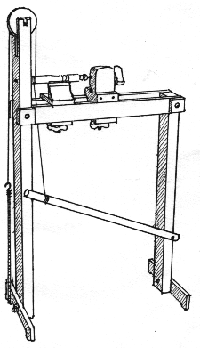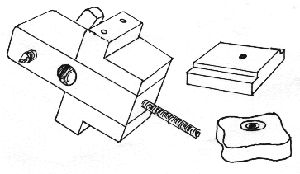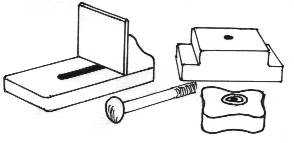A Poleless Pole Lathe

I enjoyed making this low cost lathe which is quickly and easily built, is light but stable, and folds away nicely. Although shavings are produced at a reduced rate, the lathe helps you get fit in a more interesting way than on an exercise bike. Also, mastering the skew chisel on this lathe is very character building; the secret of success being to withdraw your tool a wee bit every time you lift your leg.
As Fig.1 hopefully shows, the lathe is basically a pole type but the pole has been replaced by a bungee cord hooked under the left foot and attached to a cord which goes over a pulley, around the work twice and is then fixed through a hole near the end of a foot-operated piece of broom stick. the stick is hinged on a strong screw through the other end.
Quoting from an article in the Encyclopedia Britannica 1880 "An 18th century lathe had a lath attached to the ceiling. This lath, having immortalised itself by giving its name to the lathe, has now almost entirely disappeared."
The components are :-
Left pillar 50" x 3 1/2" x 1 3/4" pine
Right pillar 37" x 3 1/2 " x 1 3/4" pine
Bed (2) 29" x 2 1/2" x 3/4" hardwood
Feet (2) 15" x 2 1/2" x 3/4" hardwood
Coach Bolts (2) 6"x 3/16" for bed.
(2) 3" x 3/16" for feet
(1) 5" x 1/2" for toolrest
Four squares of plywood 2 1/2" x 2 1/2" x 1/4" are glued to the bed ends to prevent possible splitting when the nuts are tightened.
Foot-operated dowel 1 1/4" diam.x 29".
The wheel is of 3/4" plywood, 4 1/4" in diameter. The axle., a press fit in the wheel, is a 1/4" steel rod 3" long and resting in 1" deep slots.
The centres are made from 1/2" threaded rod. An easy way to point one end of the rod is to put the rod in an electric drill. Then while it is rotating, hold it firstly against a bench grindstone and then against a range of wet and dry sandpapers to get a smooth finish.

The tail stock, Fig. 2, and the tool rest Fig. 3 both made from pine, are clamped to the bed using a washer and a nut embedded in car body filler in a plywood handle shaped on the bandsaw.
The tailstock centre, which is a tight friction fit, has a wooden adjusting handle. This was fitted by drilling a 1/4" hole through the length of the handle and through the end of the threaded rod, and then fixing in a piece of 1/4" rod using body filler. The hole shown below the tailstock centre is to give room for a nut to be fitted to the threaded rod used for clamping the tailstock down.

Fig. 3 shows the toolrest. a piece of 1/4" plywood glued to a support as shown. The top is 1/4" below the centre height of 3 1/2"'.
originally on vicnet.net.au
